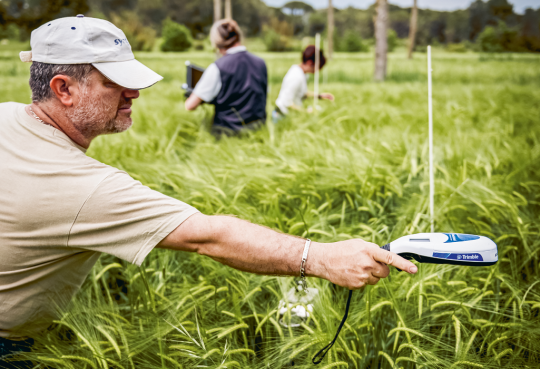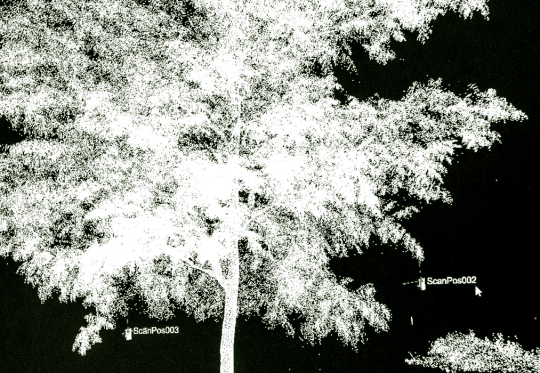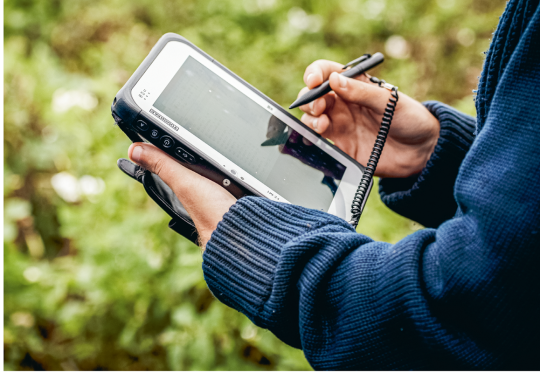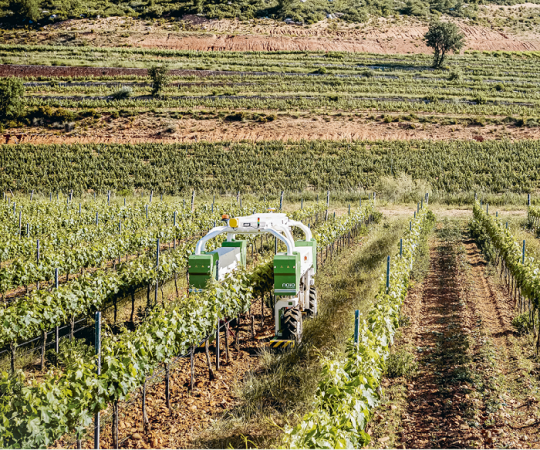Ressources dossier
AgroecologyOn track for agroecology
Published on 07 April 2023
Climate change, soil impoverishment and biodiversity loss are producing a growing crisis of identity for the agricultural sector. To compound these pressures, we have seen a rise in the global human population and food demand, a fall in the numbers of available agricultural workers and, in Western countries, increasingly strong public demand for environmentally friendly, healthy and affordable production methods. The two most recent crises for Europe – COVID19 and war in Ukraine – have demonstrated our resilience, but have also exposed the vulnerabilities in our agriculture, reminding us that the issue of food security1is still very much on the agenda. Agroecology is particularly well placed to adjust to these many challenges by putting ecosystems at the heart of production models, reasserting the local nature of food and recalibrating the value chain to give greater recognition to producers. The question is, can digital accelerate this transition? Despite attempts to construct an oppositional narrative for agriculture and digital, the two in fact operate as different dimensions of a complex system and INRAE has set itself the task of studying and encouraging the synergies between them, aiming to produce healthy and sustainable farming and food systems in which farmers retain their autonomy of decision and action. Digital has indeed been shown to be a lever for agroecological transition, with the potential to support and accelerate the adoption of this model. But we have to look at how this will work in practice.
1. Food security, as defined by the Committee for World Food Security, exists when “all people, at all times, have physical and economic access to sufficient, safe and nutritious food to meet their dietary needs and food preferences for an active and healthy life”. This definition was agreed at the Rome summit of 1996, and is to be found in the World Food Summit Plan of Action.
Combining agronomy and ecology
Agroecology is well placed to adjust to the many challenges of food security by putting ecosystemsat the heart of production models.
Inevitably, we are landing on the issue of sustainability. According to the United Nations, food sustainability depends above all on food security, that is, on the provision of adequate, healthy and nutritious food for all. The United Nations also extends its definition to include practices that are culturally acceptable, financially equitable and accessible to all and, importantly, it also includes the need to reduce the toll taken on the environment. To reduce the harm done to the environment and to cut down on losses and waste, we must re-think agricultural systems, like food systems, in a global and cross-cutting way. All the links in the chain must be integrated, from the enterprises and industries that support agricultural production (seed production, fertilisers, etc.), to logistics and distribution once products have left the agrifood processing lines. Two agricultural models have been recommended by the HLPE: sustainable intensification and agroecology. The second, which is a break away from the conventional agricultural practices of developed countries, has been adopted by INRAE, pursuing a model that is supported by both the European Union and France.

So what is Agroecology? As its name suggests, this model combines the principles of agronomy and ecology. It sets out to improve the way that ecosystems function, enhancing their self-regulatory capacity while alleviating the pressures placed on them by human activity. It reduces the use of synthetic inputs (pesticides, fertilisers, antibiotics) and is built around the principles of ecology and functional biodiversity, displaying sobriety and respect for the cycle of natural inputs (water, organic matter, nutrients). It thus acts as a brake on the pollution of soils and watercourses, conserves resources and encourages natural regeneration. It generates benefits for animal welfare and promotes a better living for farmers (revenues, independence, the continuation of family farming, decent jobs, etc.).
According to Xavier Reboud, appointed to lead the Agriculture and Digital project by INRAE’s scientific directorate on Agriculture, “Agriculture is going to change, whatever we do. That doesn’t mean that we can’t make use of digital technology to accelerate that change. Developing agroecology on a large scale is no easy task. Its ecosystems are more complex than those of traditional agriculture. They need careful management, adjusting to variations in both the immediate conditions and the wider environment. And, sometimes, we just don’t have the knowledge. We need to learn more on how to manage intercropping and get to know our soils better, to explore how microclimates work and discover more about the vast number of microorganisms that can either help or hinder farmers. And that is simply not possible without the help of digital tools.
One issue that research is going to have to address in the medium term is the possible use of digital twin technology on farms to support the agroecological transition. If we were to use this technology on farms, it would involve the creation of digital ’twins’, exact virtual replicas of particular physical features such as fields, animals or machines, whose creation is made possible by the use of data from sensors and cameras on the ground. They could help to optimise water use, guide the distribution of seed and the targeted application of fertilisers, reduce pesticide use, or track a herd’s state of health.”
Improving ecosystem management by expanding our knowledge
Ecosystems function in a highly complex manner. We are only just beginning to explore their processes and functions – the ways organisms interact, the effects of biodiversity, the ability of certain species to resist, recover and adapt when confronted with disease, parasites or climate hazards, and the composition and capacities of the soil. We need to know far more than we do at present about biodiversity, habitats and how they function, if we are to reproduce their benefits to agriculture or even attempt to guide their evolution in response to climate change. Farming practices such as intercropping, crop rotation, the use of service crops and the diversification of varieties and breeds are all agroecological levers that are directly inspired by biodiversity. The many operations required to monitor them closely can be mastered and managed with the help of digital systems.
The use of sensors to collect large-scale data on the landscape and behaviours, the massive data used in genomics and the development of vast computer-processing and storage capacity have created the opportunity to understand and model the behaviours of species, crops and agrosystems. While applying different constraints or different technical approaches. At the same time, apps for farming advice and planning make it easier for farmers to manage complex cropping systems and to combine several different performance criteria such as yield, quality and environmental impact.

A meadow, with the diversity of species it contains, offers a smaller-scale example of a complex system. Grazing their herds on pasture is advantageous to livestock farmers in terms of both their place in the local economy (giving them greater autonomy within the system) and the health and productivity of their animals. For these gains to be achieved, though, it is critical to be able choose a seed mix that will produce the characteristics farmers want. Co-created by the MAGELLAN team from INRAE’s Occitanie-Toulouse AGIR joint research unit with the help of 300 livestock farmers and 16 agricultural advisers, the CAPFLOR app offers advice to farmers on seed mixtures (containing between 6 and 14 species or varieties). It enables them to choose mixes that are not only suited to the soil types and climate conditions of their chosen fields, but also fit with their particular farm management practices.
Looking beyond the field boundary
Digital technology can also help to identify flows of materials, allowing existing systems to be modelled and new circular economic models to be generated. For example, the Organix marketplace set up by Suez allows organic-waste producers and the managers of anaerobic digesters to work together to optimise waste supplies and flows. The Maelab startup, incubated by the Agronomy and Environment laboratory (INRAE-University of Lorraine), helps local people to create and evaluate scenarios for transformation at the field, farm and local-area scales. An associated research project, currently being developed as part of the wider FairCarboN Priority Research Programme and Infrastructure (PEPR) launched in 2022, involves the creation of a multi-agent modelling platform. It will be able to assess carbon dynamics at local scales. Ultimately, this project will make it possible to assess carbon flows, proposing scenarios for change with a 2030-2050 horizon and focusing in particular on industrial practices and spatial planning.
Contributing to ecosystem services
Reducing air, water and soil pollution by the adaptive use of organic fertilisers, managing soils and planting cover crops to limit greenhouse gas emissions (GHGs) or, again, restoring biodiversity through hedge planting and the creation of permanent meadows, are all considered to be ecosystem services. Véronique Bellon-Maurel, Director of #DigitAg, tells us more about how digital technology can help: “Just as digital enables us to create individually-tailored medical services, it can also be used to monitor agricultural and ecological systems. The forthcoming version of the European Common Agricultural Policy calls for a more detailed assessment of the impacts of farm production and for the more sober management of resources (a 20% reduction in mineral nitrogen inputs, for example, under the Green Deal). Member States are expected to transition to systems that make it easy to generate large quantities of data on carbon capture, soil nitrogen levels and the state of biodiversity.”
In France, of the human activities responsible for the emission of GHGs, agriculture is ranked equal second with manufacturing (contributing 19% of the total). The chief culprits are livestock farming, which can lay claim to 48% of total agricultural emissions (mostly via methane, CH4), and cereal crops, which contribute 40% (mostly nitrous oxide, N2O). Since 1990, though, agricultural emissions have been falling at a steady rate (9%). One of the various emission reduction schemes to reduce the contribution of agriculture, the 4 per 1,000 initiative launched by INRAE, sets out to achieve a 0.4% world-wide increase in carbon sequestration across all types of agricultural soils (arable, forests, meadows), matching the annual increase in global CO2 emissions generated by human activities. It plans to do so by creating and maintaining permanent grasslands and by changing agricultural practices in grain-growing areas.
Meanwhile, policies such as the European Green Deal and France’s national low-carbon strategy seek to encourage environmentally-friendly practices, including carbon sequestration. To be certain that they are effective, we need indicators we can trust. The European NIVA (New IACS Vision in Action) programme, to which INRAE is a contributor, is working on methods to calculate three Common Agricultural Policy indicators: carbon sequestration, nitrate removal and biodiversity. The approach combines data from many sources, including the French RPG (part of the wider CAP land-parcel identification system, recording details provided by farmers such as parcel plans, crops produced and activities), the SENTINEL satellites, open-source data such as weather data, and the data provided directly by farmers themselves. These disparate data have to be processed by dedicated software so they can be linked and analysed together at the correct scale.
New-found freedom for farmers
Microchips that automatically detect unusual behaviours in cows allow farmers to reduce the time they spend monitoring a herd, while they can cut down on drudgery by using automated systems to deliver food to feeding troughs, or robots to carry out other tasks. Such digital developments free up farmers to work on their action priorities and gain greater strategic control over their businesses which, in turn, brings them greater autonomy. The new proximity with consumers of all kinds made possible by such technologies allows farmers to tailor their production methods to their markets and gain greater control over their income levels. By making visible the ways that farmers contribute to landscape biodiversity and the enhancement of common goods, and by helping them to strengthen these contributions, digital technology provides a means for farmers to take pride in the actions they take for the wider benefit of society.
Avoiding waste

Losses and waste absorb 30% of the world’s agricultural production. In cereal crops, grain loss during storage can represent up to 10% of total volume and is mostly caused by the development of mould under damp conditions. The SISAM project, run by the PANAM France SAS with support from LAAS-CNRS, is currently working on a system to monitor the status of stored seed and grain and on the remote control of silo atmospheres (in terms of temperature, humidity, CO2 and pressure levels). This not only saves on seed, it also allows farmers to avoid the application of post-harvest treatments and optimise their energy consumption. In towns and cities, too, apps such as TooGoodToGo enable individuals to buy goods that are reaching their sell-by dates, contributing to waste reduction and the local circulation of foodstuffs.
To function properly, agroecological approaches to sustainability require systemic engagement across an entire local area. Calling for a wider strategic vision, they also improve community resilience. With the support of digital technologies, it becomes possible for the agroecological model to be applied on a large scale. That is not to say, though, that there are no pitfalls along the way.
The robotics revolution
Robots, like models, have to evolve to meet new needs and they must be able to adapt to the variations they will encounter in crop development, farmed animals or environments.
This is particularly true in the case of selective hoeing and weeding. These techniques that fell into disuse with the advent of phytosanitary products, have re-emerged as possible solutions decades later, now that the drawbacks of synthetic chemicals have belatedly been recognised. The ROSE Challenge, an experimental research programme funded jointly by the French Ecophyto programme and the ANR, has pitted four teams of public researchers and equipment providers against each other in a quest for mechanical and technological alternatives to herbicides. The projects cover the whole chain, providing integrated robotic solutions from the initial identification of weeds on crop rows through to their selective elimination.

The adaptive capabilities of robotic tools can decide the success or failure of the sort of high-precision performance that is needed to differentiate between highly complex crops and to carry out targeted and specific actions. At larger scales, the manual execution of such tasks becomes a practical impossibility, creating demand for a new generation of autonomous tools. Here, robotic design is moving beyond the use of single machines that operate individually to groups of robots that can act in concert. Farmers select the number of robots they need for a particular task and assign them different roles depending on the nature and context of the work to be carried out. These new modular agricultural systems are lighter-weight, causing less soil compaction, and are able to cooperate with each other. There is no reason why such systems should not be shared by a group of farmers. This sort of radically new vision will be one of the legacies of the Adap2E project1.
INRAE has also teamed up with SabiAgri, the agricultural equipment manufacturer, to work on human-robot dialogue. The Tiara2 laboratory is conducting research on the decision-making capabilities of artificial intelligence and the on-line reconfiguration of robotic behaviours. This work has been scaled up to national level, where Inria, the CEA and INRAE are coordinating the NinSar project, working with the French robotic community to develop the smaller and more manoeuvrable mobile manipulators that are needed as part of agroecological crop management3.
1. Adap2E (Adaptive Autonomous Production Platform for the Environment) is an ANR Young Researchers project run by the TSCF research unit with the help of the ITAP joint research unit.
2. Tiara (Toward intelligent adaptable robots for agriculture) is a collaborative research programme funded by the ANR as part of the LabCom 2019 programme, bringing together the Romea team from the TSCF research unit and the SabiAgri company.
3. Funded under the Agroecology and Digital PEPR and supported by the Sadea acceleration strategy.
-
Aliette Maillard
(Send email)
Author / Translated by Teresa Bridgeman
-
Sophie Nicaud
Author
-
Philippe Fontaine
Author
-
Nicole Ladet
Author
